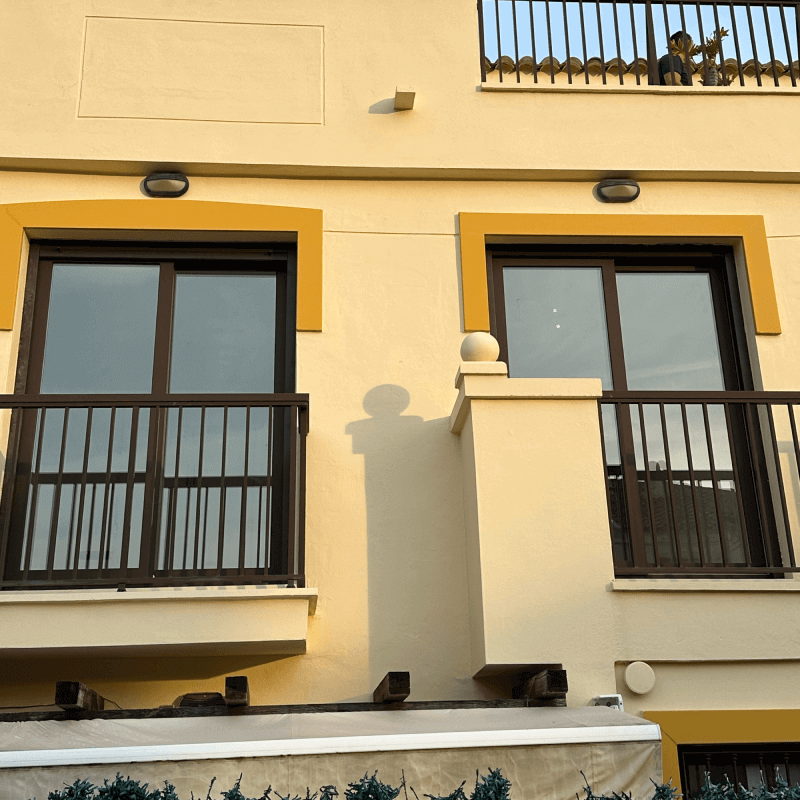Solutions for the Northern Regions of Spain
· María Fernández · General knowledge · 8 min read
The northern coast of Spain is a different country from the Mediterranean south. Here, people don’t scorch in the sun; they chill in the Atlantic winds and struggle with constant humidity. Windows for this region require a completely different design.
Climate of the Northern Regions
High humidity (75-85% year-round) is the main problem. Condensation appears on windows from October to April, and moisture accumulates on slopes and window sills. Without proper windows, mold forms, wallpaper peels off, and furniture deteriorates.
Frequent rainfall – Galicia and Asturias receive 1,200-1,500 mm of precipitation annually. This is three times more than Madrid. Water finds any gaps in the installation; the sashes must fit tightly even in strong winds.
Cool summers and cold winters require good thermal insulation. Temperatures drop to 5°C in winter, and rarely rise above 25°C in summer. Homes need to be heated 6-7 months a year, so the energy efficiency of windows directly impacts bills.
Strong winds from the Atlantic put stress on windows and blow through poorly sealed seams. Wind speeds regularly reach 80-100 km/h, especially in exposed coastal areas.
Choosing a Profile Material
PVC windows are the optimal solution for northern regions. Plastic is moisture-resistant, requires no painting, and provides the best thermal insulation of all materials.
For northern Spain, choose profiles with at least 5 chambers and a mounting depth of 70 mm. This provides a U-value of 1.1-1.3 W/m²K—enough for winter comfort without high heating costs.
The multi-chamber profile design acts like a thermos. The air in the chambers prevents cold from entering and heat from leaving. A house with such windows requires 30-40% less energy for heating compared to old wooden frames.
The reinforcement inside the profile must be closed around the perimeter. This is important in humid climates, as exposed reinforcement accumulates condensation inside the profile, leading to corrosion and deformation of the frame.
Aluminum windows for residential buildings in the north are only suitable with a high-quality thermal break of at least 24 mm. Without insulation, aluminum freezes, the sashes become coated with ice from the inside, and condensation forms.
Aluminum makes sense for large sliding systems for access to a terrace or for unheated spaces such as verandas and conservatories. The strength of the material allows for the construction of lightweight, large structures.
On the humid Atlantic coast, be sure to choose profiles with an anodized coating. Powder coating without additional protection will fade and peel from constant moisture within 5-7 years.
Wooden windows fare better in the north than in the south, but require regular maintenance. High humidity is wood’s main enemy. Without proper protection, wood absorbs water, swells, and rot and mildew develop.
Choose windows made of laminated timber of hardwoods such as oak or larch. Even treated pine is too soft for humid climates. The protective coating should be specially formulated for humid regions and contain fungicides against mold.
Maintenance of wooden windows in the north requires every 4-5 years—check the coating’s condition and renew it if cracks appear. This incurs an additional cost of €150-€200 per window, which should be factored into your budget.
Double-glazed windows for northern regions
Double-glazed windows are mandatory for residential buildings. The 4-16-4-16-4 formula provides a heat transfer coefficient of 0.7-0.8 W/m²K—twice as good as single-glazed windows.
Low-emissivity glass reflects radiant heat back into the room, preventing heat from escaping through the windows. In winter, this reduces heat loss by 50% compared to standard glass. The additional cost of the low-emissivity coating pays for itself in 3-4 years of heating savings.
Filling the chambers with argon improves thermal insulation by 15-20%. Argon is denser than air and conducts heat poorly. For northern regions, this is a useful addition, costing an additional 20-30 euros per square meter.
A warm spacer between the panes prevents the edges of the double-glazed window from freezing. A standard aluminum frame creates a thermal bridge where condensation and ice form. A composite frame solves this problem.
Solar-control glass is unnecessary in the north. The problem here isn’t the heat, but the lack of solar heat. Regular clear glass transmits maximum light and heat, which is useful in cloudy climates.
Combating Condensation
Condensation on windows is a major problem in northern regions. The moisture appears due to the difference in temperature between the inside and outside of the room, coupled with high humidity.
High-quality window insulation is the first requirement. The warmer the inner surface of the glass, the less likely condensation is to form. Double-glazed windows with a low-e coating maintain the temperature of the inner glass 3-5 degrees higher than standard ones.
Supply ventilation is essential in homes in northern Spain. Constant air exchange removes excess humidity from the room. Supply valves built into the windows ensure draft-free air circulation. Automatically adjustable valves open more when indoor humidity rises and close when there’s a strong wind outside. This maintains an optimal microclimate without your intervention.
Wide window sills promote air circulation around the windows. Don’t block heating radiators under windows with decorative screens—warm air should rise along the glass, preventing condensation.
Insulated slopes reduce freezing around the window perimeter. Without insulated slopes, even the warmest window will collect moisture at the edges where the cold wall meets the frame.
Sealing and Moisture Protection
In northern Spain, the quality of installation is more important than the choice of the window itself. Water will find every crack.
Three-layer sealing of the mounting joint is mandatory. An internal vapor barrier prevents moisture from the room from penetrating the foam. The middle thermal insulation layer is the foam itself. The outer vapor-permeable layer wicks moisture away from the foam but prevents water from entering.
Without proper sealing, the foam absorbs water, loses its thermal insulation properties, and deteriorates within 2-3 years. This leads to drafts, thermal bridges, and mold.
Drip caps direct water away from the wall. Without a drip cap, water runs down the façade, penetrates between the drip cap and the wall, and enters the joint. A properly sealed drip cap protrudes at least 30 mm from the wall and is bent downwards.
The sealant around the perimeter of the frame should be a neutral silicone with fungicides. Acidic silicone will destroy metal and paint, and standard sealant without additives will become moldy within six months in humid climates.
Hardware for Humid Climates
Stainless steel is required for all metal components. Conventional galvanized hardware rusts in humid climates, even inside the profile where it’s not visible. Sticking hinges and latches are a common problem with inexpensive windows in northern climates after 3-4 years of use.
Multi-point locking systems with 3-5 locking points ensure a tight seal around the entire perimeter of the sash. This is critical for protection from drafts in strong winds. Windows with a single locking point allow air and moisture to pass through even when closed.
Adjustable sash pressure should be included in the design. In winter, the sash should be pressed tighter for better insulation; in summer, the pressure can be loosened for easier opening and a longer lifespan of the seals.
Lubricate the mechanisms regularly—every 6 months. Humidity accelerates wear on moving parts, even in high-quality hardware.
Seals and Maintenance
Rubber seals are the weak point of any window in a humid climate. Constant contact with water and temperature fluctuations degrade the rubber faster than in drier regions.
Double sealing is essential for northern regions. If the first seal lets moisture through, the second will stop it. Windows with a single seal begin to leak after 3-5 years.
EPDM rubber lasts longer than standard rubber—up to 15-20 years instead of 7-10 years. It is 10-15% more expensive, but does not require replacement with regular maintenance.
Seal maintenance is simple: wash them with soap and water once a year and treat them with silicone spray. This maintains the elasticity of the rubber and extends its service life.
Opening Types for Northern Regions
Tilt-and-turn windows are standard in northern Spain. The tilt position provides draft-free ventilation, which is important in windy weather. Full opening is necessary for cleaning and summer ventilation.
Sliding systems for humid climates require special care. The tracks should be cleaned of dirt once a month, otherwise the mechanism will jam. Sliding windows are less airtight than tilt-and-turn windows—they allow more drafts in during the winter.
If you choose a sliding system, choose models with a lift-and-slide mechanism. When closing, the sash lowers and presses firmly against the frame, providing better insulation.
Window Costs for Northern Regions
PVC windows with double-glazed windows and high-quality fittings start at €320 per square meter, including installation.
Aluminum systems with a 24 mm thermal break start at €480 per square meter.
Wooden windows with insulation for humid climates start at €650 per square meter.
Correctly selected windows pay for themselves in heating savings within 5-7 years. Cheap, poorly insulated windows increase heating costs by 40-50% annually.
When to Replace Windows
Old wooden windows in northern Spain are a major source of heat loss. If your home is cold in winter even with the heating on, your heating costs exceed €150 per month, and condensation forms on the windows, it’s time to replace the windows.
Replacing windows in a 100 m² house costs €4,000-6,000. Heating savings amount to €600-900 per year. The investment pays for itself in 5-7 years, after which you simply save money every month.




